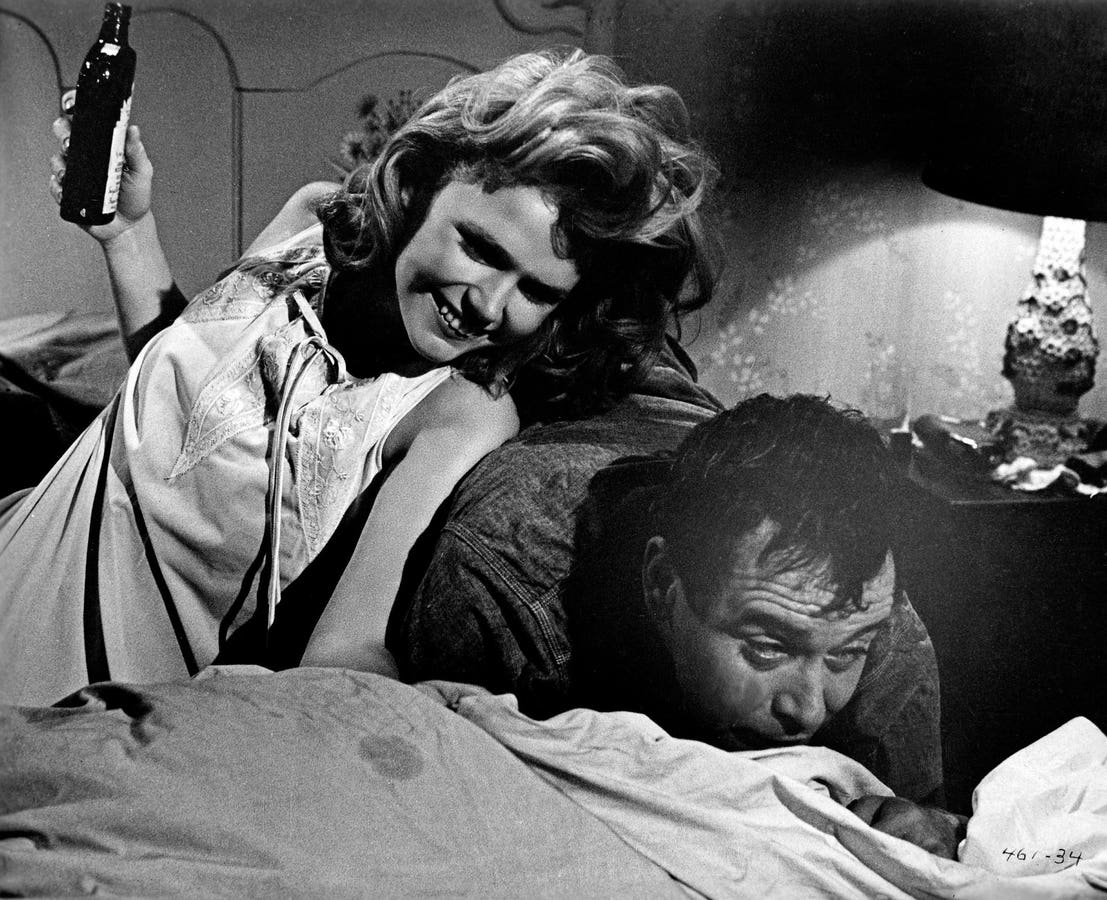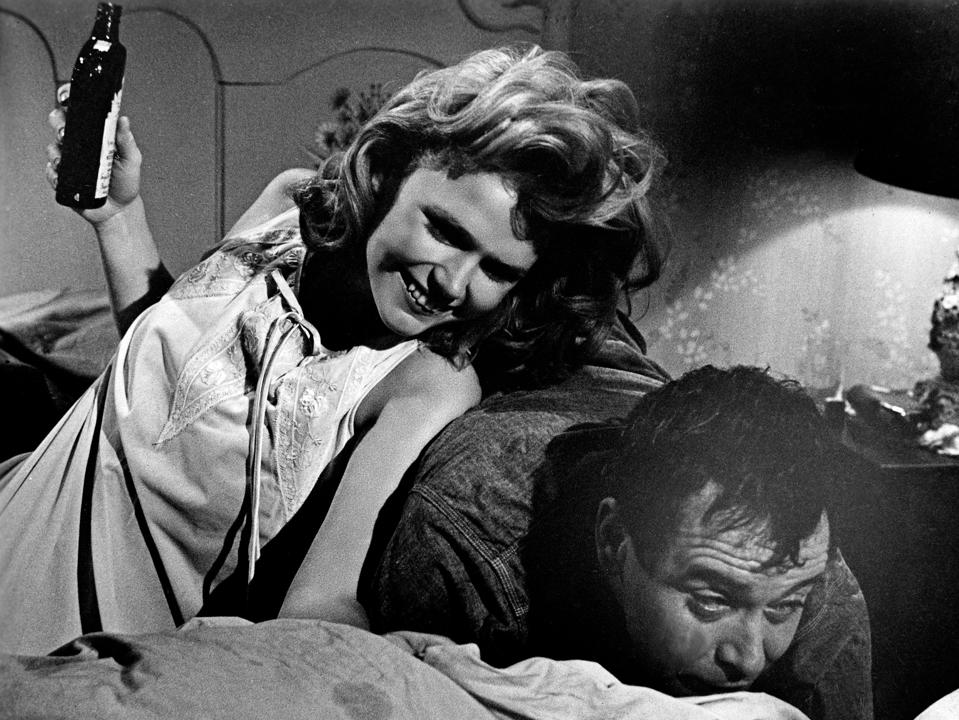‘Days of Wine and Roses’ is one of many films showcasing the glitz, glamor and gore of alcohol. But Hollywood needs to show that recovery is possible using medications and therapy.
FilmPublicityArchive/United Archives via Getty Images
[Spoiler alert for the film, Days of Wine and Roses]
Over the past few weeks, several high-profile individuals sadly passed away including wrestling champion Hulk Hogan and Black Sabbath legend Ozzy Osbourne. While alcohol was not the cause of death for either individual (Osbourne’s official cause has yet to be revealed), both men were very public about their battles with and triumphs over alcohol addiction. Alcohol is not new to the entertainment industry. Many films have depicted alcoholism with varying degrees of accuracy mixed with a large dose of sensationalism.
I first saw Days of Wine and Roses at New York City’s Film Forum this spring during a tribute to Jack Lemmon. This film is neither the first nor will it be the last to portray the glamour and gore of alcohol. The 1962 Oscar-winner features a newlywed couple—played brilliantly by Lemmon and Lee Remick—whose spiraling descent into a booze-filled oblivion is both gripping and heartbreaking.
Hollywood and alcoholism go way, way back. Scores of films showcase the damaging effects of alcohol including Leaving Las Vegas, Clean and Sober, Crazy Heart, When a Man Loves a Woman, A Star is Born (all four versions) and many more. Art certainly imitates life as alcohol isn’t just a plotline but a major player in the lives of the movie stars themselves. From Richard Burton and Elizabeth Taylor to Brad Pitt and Jamie Lee Curtis, celebrities have been deeply impacted by alcohol, much like everyday people.
Over the past three decades, alcohol-related cancer deaths have doubled in the United States, disproportionately impacting men and people 55 and older. Excessive drinking is the leading preventable cause of death in the U.S., killing 178,000 people each year. That’s more than diabetes and liver disease combined.
Starts Off Innocently Enough
The late Ozzy Osbourne was very open about his battles with alcohol and other substances, as well as his recovery.
Getty Images
Nobody drinks a glass of Merlot or a bottle of Heineken with the intention of ruining their life. In Days of Wine and Roses, we see Lemmon’s character, Joe Clay, drinking at a work event. Seems social and harmless. Remick’s character, Kirsten Arnesen, doesn’t drink at all. She doesn’t understand all the fuss over alcohol. When Clay asks, ‘Don’t you want to feel good?’ Remick replies, ‘I already feel good.’ If only she were able to hold onto that feeling of positivity and confidence.
But she does love chocolate, and Clay leverages that desire into ordering her a Brandy Alexander, a cognac-based cocktail containing crème de cacao. An AA sponsor, played perfectly by Jack Klugman, later suggests that Kirsten’s chocolate cravings indicate an addictive tendency, which I believe is an oversimplification. It’s also not medically accurate.
Nobody really has an “addictive personality” or tendency. People have risk factors that can increase their chance of developing a problem with a substance. In Kirsten’s case, she is lonely and bored while caring for a baby alone. She also likely developed clinical depression (‘Everything looks dirty when I don’t drink.) All of these factors can increase her likelihood of drinking. Wine soothed her isolation and sadness, as it does for millions of others—at least for the short-term.
First Step: Recognize The Problem
It isn’t until Clay looks at his reflection in a store-front window on his way to a bar that he realizes he looks terrible. Alcohol was the cause. He turns around, goes home and tells his wife that they both need to stop drinking because it’s ruining their lives. ‘I’ve had four jobs in five years,’ he confesses, not because of a bad economy but because of his poor performance. He recognizes that he has a problem and needs to stop. Kirsten, sadly, is a different—and not unique—story. Over half of Americans don’t view addiction in general as a chronic brain disease that can be successfully treated. Stigma is perhaps the biggest barrier to seeking help. Studies show that people with alcohol use disorder (AUD) cite embarrassment, shame and a sense of personal failure as reasons for not getting treatment.
Women And Alcoholism
Oscar-winner Jamie Lee Curtis is one of many female celebrities who struggled with alcohol including Judy Garland, Drew Barrymore, Demi Lovato and Lindsay Lohan. Alcohol use is rising among women. Curtis has been sober for 26 years.
Getty Images for AFI
Women like Remick’s Kirsten face unique challenges. Throughout the film, she refuses to acknowledge her drinking as a problem. She declines AA because ‘I’m not an alcoholic.’ Instead, she wants to use her willpower to stop. Many of my own patients share the same beliefs until they realize their cravings overpower their will.
Alcohol consumption has been on the rise among women for several years, exacerbated by the Covid-19 pandemic. The largest increases in drinking were observed among Black and Hispanic women (173% and 148%, respectively) but mostly among women with children under the age of five (323%), like Kirsten. Many of the latter left paying jobs to homeschool young kids. Women were overwhelmed, frustrated, anxious and depressed. Alcohol was a coping mechanism.
Women face several alcohol-induced health problems. Over the past 20 years, women have had larger increases in alcohol-related emergency department visits, hospitalizations, and deaths compared to men. Women who drink heavily are more likely to develop alcohol-related liver damage (hepatitis and cirrhosis) and heart disease compared to men who drink the same amount.
Research also shows that alcohol misuse can cause brain damage more quickly in women versus men. For example, one study showed that binge-drinking teenage girls had less brain activity and poorer performance on memory tests than peers who drank little or abstained. Teenage boys did not display similar brain injury.
Despite the numerous adverse health consequences, women are less likely than men to seek treatment. But help is available.
Second Step: Get Help
Jack Lemmon kissing Lee Remick in a scene from the film ‘Days Of Wine And Roses’, 1962. Of the 30 million Americans with an alcohol addiction, less than 8% get treatment. Women face worse health outcomes than men.
Getty Images
After an alcohol-fueled night, Clay destroys his father-in-law’s greenhouse and is admitted to a sanatorium. We see him lying flat on a bed confined in a straitjacket, writhing in pain, shaking and dripping in sweat. He was likely experiencing delirium tremens (DT), a life-threatening manifestation of severe alcohol withdrawal that requires immediate medical attention. Today, if I forced a patient to stop drinking by tying her up in a straitjacket, I would be sued for medical malpractice and would likely lose my medical license. Lemmon’s character sought help from his AA sponsor and attended meetings. He was able to get a job and take care of his daughter. He sought help for his health problem, just as a person with asthma sees a doctor and uses inhalers to breathe better.
Most People Get Better
Despite the prevalence of alcohol use and misuse, less than 8% of people with AUD receive treatment. We need to raise awareness of evidence-based treatment for alcohol addiction. While mutual support groups like Alcoholics Anonymous work for some, it is not helpful for many others who consider AA judgmental, religiously-driven and not rooted in science. Over years, data has shown that people who have the best outcomes for long-term recovery from AUD receive a combination of medical, psychological and social support interventions.
FDA-approved medications include naltrexone (“Revia” or “Vivitrol”), an opioid receptor blocker that reduces cravings and is considered first-line treatment; acamprosate (“Campral”) balances brain neurotransmitters and has a high safety profile; disulfiram (“Antabuse”) causes sickness when people drink and is most effective in those motivated to quit; topiramate (“Topamax”), an epilepsy medication that is used off-label for AUD, has been shown to reduce cravings and drinking frequency.
In addition to medications, behavioral (or talk) therapy led by a licensed therapist has been shown to reduce drinking by helping people develop coping strategies, handle stress, change thinking patterns and prevent relapse. Sessions can be individual, group or family-based. Cognitive behavioral therapy (CBT), motivational interviewing and contingency management are a few examples of behavioral therapy modalities. Naltrexone and CBT in combination has been found to be very effective in reducing drinking.
Medically supervised detoxification is indicated for moderate-to-severe AUD in order to reduce the risk of seizures or DTs, as Clay was experiencing in the film. Benzodiazepines such as chlordiazepoxide (“Librium”), diazepam (“Valium”) and lorazepam (“Ativan”) are also used during detox.
In addition to medications and counseling, peer support and mutual help groups such as AA have been shown to be helpful for many people. Groups vary widely so it’s important to find one that’s a good fit. SMART Recovery and LifeRing are evidence-based, secular alternative recovery programs.
Utilizing harm reduction approaches is key. We need to meet people where they are. In the addiction field, we do not recommend forced abstinence or recovery. We remind family members that their loved one will seek help when they’re ready. This is hard to hear for most people who have difficulty watching a family member struggle.
Young Adults Are Drinking Less
Gen Z and Millenials are drinking less alcohol than older generations.
getty
While overall alcohol consumption has increased, Gen Z has been cutting back on drinking. Millennials are drinking less, too. In fact, a 2023 Gallup survey found that the percentage of people under 35 who ever had a drink dropped from 72% two decades ago to 62% in 2023. Why is this? A primary reason is the increased diversity in race and ethnicity of young adults. Non-white Americans aged 18 to 34 have consistently consumed less alcohol than their white counterparts. Young people are also concerned about alcohol’s health risks: 52% believe that moderate drinking is unhealthy, up from 34% five years ago. Changing socialization patterns could also be part of the shift. Alcohol tends to be a social drug. Young adults socialize less in-person today than they did in 2003, dropping from 30 hours/month to 10 hours/month.
Positive Trends
In addition to younger people drinking less, treatment strategies are expanding. Telehealth appointments are making it easier for people to see a doctor or counselor about their drinking, prompted by the pandemic. GLP-1 receptor agonists such as semaglutide and other anti-obesity medications as well as psychedelics like LSD and psilocybin are also showing promise in reducing alcohol consumption and cravings but more research is needed.
While Days of Wine and Roses had some inaccuracies about alcohol addiction, it demonstrated a key point made by my former colleague, mentor and addiction expert, the late Dr. Richard Saitz: it’s a tough disease. Some people like Clay recognize they have a problem and get help. Others like Kirsten are not ready—a difficult realization for not only loved ones but for medical professionals like me. We need to continue to be supportive and let people know that effective treatment is available once they’re ready.









